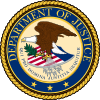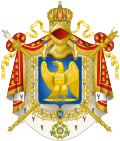- Charles Joseph Bonaparte
-
Charles Joseph Bonaparte 
37th United States Secretary of the Navy In office
July 1, 1905 – December 16, 1906President Theodore Roosevelt Preceded by Paul Morton Succeeded by Victor H. Metcalf 46th United States Attorney General In office
December 17, 1906 – March 4, 1909President Theodore Roosevelt Preceded by William H. Moody Succeeded by George W. Wickersham Personal details Born June 9, 1851
Baltimore, Maryland, U.S.Died June 28, 1921 (aged 70)
Baltimore County, Maryland, U.S.Political party Republican Spouse(s) Ellen Channing Day Bonaparte Alma mater Harvard University Profession lawyer Religion Roman Catholic[1] Charles Joseph Bonaparte (June 9, 1851 – June 28, 1921) was an American lawyer and political activist from Maryland who served in the Cabinet of President Theodore Roosevelt. Bonaparte was Secretary of the Navy and then Attorney General. While Attorney General, he created the Bureau of Investigation (now the FBI). He was a great-nephew of Emperor Napoleon I of France.
Contents
Biography
Charles Joseph Bonaparte was born in Baltimore, Maryland. He was the son of Jérôme Napoleon Bonaparte (1805–1870) and Susan May Williams (1812–1881), from whom the American line of the Bonaparte family descended, and a grandson of Jérôme Bonaparte, the youngest brother of Emperor Napoleon I. However, the American Bonapartes were not considered part of the dynasty and never used any titles.
He graduated from Harvard University and Harvard Law School, where he later served as a university overseer. He practiced law in Baltimore and became prominent in municipal and national reform movements.
On September 1, 1875, Bonaparte married the former Ellen Channing Day (1852–1924), daughter of attorney Thomas Mills Day and Anna Jones Dunn. They had no children.
In 1899 Bonaparte was the keynote speaker for the first graduating class of the College of Notre Dame of Maryland. He spoke on "The Significance of the Bachelor's Degree":
Today, and here for the first time in America, a Catholic college for the education of young ladies bestows the bachelor's degree...
The Style of Scholarship...which benefits the recipient of the bachelor's degree has two distinctive and essential marks. It implies in the first place a broad, generous sympathy with every form of honest, rational and disinterested study or research.
A Scholar who is also, and first of all, a gentleman may be...specially interested is some particular field of knowledge, but he is indifferent to none. He knows how to value every successful effort to master truth; how to look beyond the little things of science...to the great things - God's handiwork as seen in nature, God's mind as shadowed in the workings of the minds of men.
Young ladies, of this degree has such meaning for your brothers, what meaning has it for you [2]Bonaparte lived in Baltimore County, Maryland and his home, Bella Vista, was designed by the architects Wyatt & Nolting in 1896.[3] It lies east of Maryland Route 147. The house was not electrified since Bonaparte refused to have electricity or telegraph lines installed due to a dislike of technology, verified by his use of horse-drawn coach until his death.[citation needed]
Bonaparte died in Bella Vista, and is interred at Baltimore's Loudon Park Cemetery. He died of "Saint Vitus Dance" (chorea). A nearby street in Baltimore County bears the name of Bonaparte Ave.
After Bonaparte's death the house was later owned by bootleggers Peter and Michael Kelly. After they left, it was destroyed in a fire caused by faulty wiring on January 20, 1933. The site was replaced by a poured concrete mansion, but a large carriage house dating back to 1896 is still on the estate.[3]
Political activity
He was a member of the Board of Indian Commissioners from 1902 to 1904, chairman of the National Civil Service Reform League in 1904 and appointed a trustee of The Catholic University of America.
In 1905, President Theodore Roosevelt appointed Bonaparte Secretary of the Navy. In 1906 Bonaparte moved to the office of Attorney General, which he held until the end of Roosevelt's term. He was active in suits brought against the trusts and was largely responsible for breaking up the tobacco monopoly. In 1908, Bonaparte founded the Bureau of Investigation (BOI).
He was one of the founders, and for a time the president, of the National Municipal League.
References
- ^ Charles G. Herbermann et al., ed., The Catholic Encyclopedia: An International Work of Reference on the Constitution, Doctrine, Discipline, and History of the Catholic Church, Fifteen Volumes, Vol. II (New York: Encyclopedia Press Inc., 1913), p. 231.
- ^ Philbin, Anne Scarborough. The Past and the Promised p. 58
- ^ a b Kelly, Jacques. "Houses – Bella Vista". Baltimore County Public Library Legacy Web. http://external.bcpl.lib.md.us/hcdo/cfdocs/photopage.cfm?id=13751. Retrieved 2011-10-12.
Further reading
- Bishop, Joseph Bucklin (1922), Charles Joseph Bonaparte: His Life and Public Services, New York: C. Scribner's Sons
- Goldman, Eric F. (1943), Charles J. Bonaparte: Patrician Reformer, His Earlier Career, Baltimore: Johns Hopkins Press
Non-profit organization positions Preceded by Chairman of the National Civil Service Reform League
1904Succeeded by Preceded by
James C. CarterPresident of the National Municipal League
1903–1910Succeeded by
William D. FoulkeGovernment offices Preceded by
Paul Morton37th United States Secretary of the Navy
July 1, 1905 – December 16, 1906Succeeded by
Victor H. MetcalfLegal offices Preceded by
William H. MoodyUnited States Attorney General
Served under: Theodore Roosevelt
December 17, 1906–March 4, 1909Succeeded by
George W. WickershamUnited States Attorneys General Randolph • Bradford • Lee • Lincoln • Breckinridge • Rodney • Pinkney • Rush • Wirt • Berrien • Taney • Butler • Grundy • Gilpin • Crittenden • Legaré • Nelson • Mason • Clifford • Toucey • Johnson • Crittenden • Cushing • Black • Stanton • Bates • Speed • Stanbery • Evarts • Hoar • Akerman • Williams • Pierrepont • Taft • Devens • MacVeagh • Brewster • Garland • Miller • Olney • Harmon • McKenna • Griggs • Knox • Moody • Bonaparte • Wickersham • McReynolds • Gregory • Palmer • Daugherty • Stone • Sargent • W D Mitchell • Cummings • Murphy • Jackson • Biddle • T C Clark • McGrath • McGranery • Brownell • Rogers • Kennedy • Katzenbach • W R Clark • J N Mitchell • Kleindienst • Richardson • Saxbe • Levi • Bell • Civiletti • Smith • Meese • Thornburgh • Barr • Reno • Ashcroft • Gonzales • Mukasey • Holder
Cabinet of President Theodore Roosevelt (1901–1909) Vice President 
Secretary of State Secretary of the Treasury Secretary of War Attorney General Postmaster General Charles E. Smith (1901–1902) • Henry C. Payne (1902–1904) • Robert J. Wynne (1904–1905) • George B. Cortelyou (1905–1907) • George von L. Meyer (1907–1909)Secretary of the Navy John D. Long (1901–1902) • William H. Moody (1902–1904) • Paul Morton (1904–1905) • Charles J. Bonaparte (1905–1906) • Victor H. Metcalf (1906–1908) • Truman H. Newberry (1908–1909)Secretary of the Interior Secretary of Agriculture Secretary of Commerce and Labor Bonaparte family 1st generation 
2nd generation Edmond Raymer Bonaparte I · Zénaïde, Princess of Canino and Musignano · Princess Charlotte · Napoléon II · Charlotte, Princess Mario Gabrielli · Princess Victoire · Christine, Lady Dudley Coutts Stuart · Charles Lucien, Prince of Canino and Musignano · Laetitia, Lady Wyse · Prince Joseph · Jeanne, Marchioness Honorato Honrati · Prince Paul · Prince Louis Lucien · Prince Pierre Napoléon · Prince Antoine · Alexandrine, Countess Vincenzo Valentini di Laviano · Princess Constance · Napoléon Charles, Prince Royal of Holland · Louis II of Holland · Napoléon III · Prince Jérôme Napoléon · Jérôme Napoléon Charles, Prince of Montfort · Mathilde, Princess of San Donato · Napoléon Joseph, Prince Napoléon
3rd generation Joseph Lucien, Prince of Canino and Musignano · Princess Alexandrine · Cardinal Lucien Louis, Prince of Canino and Musignano · Julie, Marchioness of Roccagiovine · Charlotte, Countess Pietro Primoli di Foglia · Princess Léonie · Marie Desirée, Comtesse Paolo Campello della Spina · Augusta, Princess Placido Gabrielli · Napoléon Charles, Prince of Canino and Musignano · Bathile, Countess of Cambacérès · Princess Albertine · Prince Charles · Edmond Raymer Bonaparte II · Roland, Prince of Canino and Musignano · Jeanne, Marchioness of Villeneuve-Escaplon · Napoléon Eugène, Prince Imperial of France · Prince Jérôme Napoléon · Prince Charles Joseph · Victor, Prince Napoléon · Prince Napoléon Louis · Marie Letizia, Duchess of Aosta · William Charles Bonaparte-Wyse · Laetitia Marie Wyse Bonaparte · Lucien Napoléon Bonaparte-Wyse
4th generation Princess Mary, Mrs. Enrico Gotti · Eugénie, Princess of La Moskowa · Marie, Princess George of Greece and Denmark · Louise Eugenie, Countess Adam of Moltke-Huitfeld · Prince Jérôme Napoléon · Marie Clotilde, Countess Serge de Witt · Louis, Prince Napoléon · Andrew Nicholas Bonaparte-Wyse
5th generation Charles, Prince Napoléon · Princess Catherine, Mrs. Jean Dualé · Princess Laure, Mrs. Jean-Claude Leconte · Prince Jérôme
6th generation Princess Caroline · Jean-Christophe, Prince Napoléon · Princess Sophie
Categories:- 1851 births
- 1921 deaths
- House of Bonaparte
- American people of Italian descent
- American people of French descent
- American people of Irish descent
- American people of English descent
- American Roman Catholics
- People from Baltimore, Maryland
- United States Attorneys General
- The Catholic University of America trustees
- Harvard Law School alumni
- Princes of France (Bonaparte)
- American people of Corsican descent
- United States Secretaries of the Navy
Wikimedia Foundation. 2010.




